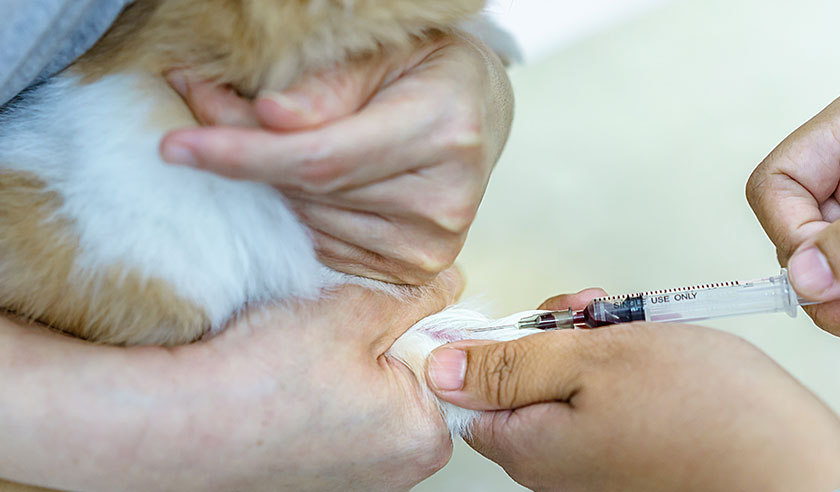There's more to having your cat spayed or neutered than managing cat populations — these procedures can help prevent certain diseases and keep stressful behavior issues at bay. But the idea of a surgical procedure, especially for kittens, can seem daunting. Don't worry! We're answering the most common questions about spaying and neutering your cat so you can make an informed decision. Keep in mind that talking to your veterinarian and asking them question is the best way to feel comfortable about your decision.
Cat Spaying FAQs
What is spaying a cat?
The medical term for spay is ovariohysterectomy (OHE). The purpose of spaying is to prevent a female cat from becoming pregnant or getting diseases that are associated with not being spayed. During the procedure, your cat's abdomen is opened, and both the ovaries and the uterus are completely removed. The abdomen is closed with sutures.
Can you spay a cat who's actively in heat?
A cat can be spayed while in heat, but it's generally recommended that you wait until they complete the heat cycle. The vessels of the reproductive tract are engorged with blood during heat, and the tissue is fragile. This increases the risk of bleeding during the procedure and can extend its length.
How much does it cost to spay a cat?
The cost to spay a cat depends on geographic location, your cat's health status, and whether you're doing the procedure in a shelter, low-cost spay/neuter clinic, or veterinary clinic.
The cost is typically higher at veterinary practices because the cat receives a more complete medical experience — physical examination, diagnostic tests, high-quality anesthetic drugs, intravenous catheter and fluids, sterilized equipment, surgical suite, and after-surgery monitoring.
Shelter’s fees are typically lower since many work with donations or grants and have volunteers for labor. They're also often given products from pharmaceutical and surgical supply companies. These clinics are intended to support cat parents for whom the cost of a veterinary clinic spay may not be feasible.
Additional fees may apply for cats in heat, pregnant, or those with pyometra (an infection in the uterus) because the procedure is more complicated and takes longer.
When should I get my cat spayed?
A veterinary task force was established in 2016 to determine at what age female cats should be spayed. They recommend that female cats be spayed before their first estrous cycle, at five months1.
In some shelters and rescues, cats are often spayed at a younger age in preparation for adoption. Spaying younger than five months of age doesn't appear to negatively impact health or behavior if the kitten is healthy enough for surgery2. There are safe and effective anesthetic drugs and protocols for cats at this younger age.
Cats can also be spayed older than five months, though the longer they remain intact, the longer they go without the procedure's benefits to their health and behavior.
How long does it take to spay a cat?
A routine cat spay takes about 30 minutes. Complications, such as pyometra or being in heat, can increase the length of the procedure.
What are the benefits of spaying your cat?
There are many benefits to spaying female cats, including:
- Avoidance of unplanned pregnancy. Cats can become pregnant as young as five months old — sometimes even younger.
- Prevention of pyometra. This is an infection of the uterus that can be life-threatening.
- Prevention of mammary cancer. The younger a cat is spayed, the more their risk of mammary cancer drops. Studies indicate as much as 91% reductions when spayed at around six months old3. Spaying at any age decreases the risk of mammary tumors by 40%-60%4.
- Prevention of behavior issues. Several behavior issues can spring up while a female cat is in heat. Her hormone fluctuations can cause extreme vocalizing, aggression, and sometimes even house-soiling. Other cats can become more stressed or reactive near a female in heat and male cats (both inside and out) can flock to the female and fight with each other.
- Efficacy of some medications. Hormonal changes that come with a heat cycle may interfere with medications for diabetes or epilepsy.
Cat Neutering FAQs
How is a cat neutered?
A male cat is neutered by the surgeon making a small incision over each side of the scrotal sac and completely removing each testicle. Sutures are generally unnecessary, and the incision is left to heal on its own.
How much does it cost to neuter a cat?
The cost to neuter a cat depends on geographic location and whether you're doing the procedure in a shelter, low-cost spay/neuter clinic, or veterinary clinic.
When should I get my cat neutered?
A veterinary task force was established in 2016 to determine at what age male cats should be neutered. They recommend that male cats are neutered at five months of age1.
In some shelters and rescues, cats are often neutered at a younger age in preparation for adoption. Neutering younger than 5 months doesn't appear to negatively impact health or behavior as long as the kitten is healthy enough for surgery2. There are safe and effective anesthetic drugs and protocols for cats at this younger age.
Cats can also be neutered older than five months, though the longer they remain intact, the longer they go without the procedure's benefits to their health and behavior.
How long does it take to neuter a cat?
A routine neuter where both testicles have descended into the scrotum tends to be a relatively quick surgical procedure taking about 15 minutes. It takes considerably longer if one or both testicles have not descended, referred to as unilateral or bilateral cryptorchid. The retained testicle must be located, and this often involves exploring the abdomen to find it.
What are the benefits of neutering a cat?
Neutering before sexual maturity lessens sexual behaviors that can lead to rehoming or surrendering to shelters, such as roaming, fighting with other cats, yowling, and urine marking/spraying inside and outside the home.
Other benefits of neutering at any age include:
- Prevention of testicular cancer. Removing the testicles via neutering eliminates this possibility.
- No unwanted litters. If there's a female in heat nearby, even the most mellow indoor male cat may try to escape to get to her. Male cats can father kittens by around four months of age.
- Increased safety. Reducing an outdoor or indoor/outdoor cat's desire to roam can reduce risks like fighting, getting lost, or being injured.
Spay and Neuter Recovery
Though they are very common procedures, spaying and neutering are still surgery and require a bit of recovery. Some cats are mildly sleepy on the day of surgery and may remain slightly sedated the following day.
Your veterinarian will provide detailed discharge instructions that must be followed for successful recovery. Some important things that you must do include:
- Give all medications as directed, even if your cat doesn't seem painful.
- If your cat is released the day of the surgery, only give small amounts of food and water that day and resume their normal diet the following day.
- Restrict your male cat's activity for the next seven days or your female cat's activity for the next 14 days — no running, jumping, or playing.
- Monitor the incision for redness, heat, swelling, or discharge.
- Don't let your cat lick, chew, scratch, or rub at their incision. If they do, you may need to use an Elizabethan collar.
- Try an additional litterbox using shredded paper or pellet litter until the incision is healed.
ZPC-02540
- Feline Fix by Five. United Spay Alliance. https://www.unitedspayalliance.org/feline-fix-by-five/. Accessed November 8, 2022.
- Is there an optimal age for cat spay or neuter. Today’s Veterinary Practice. https://todaysveterinarypractice.com/preventive-medicine/optimal-age-spay-neuter-cat/. Accessed November 7, 2022.
- Mammary Tumors. Cornell Feline Health Center. https://www.vet.cornell.edu/departments-centers-and-institutes/cornell-feline-health-center/health-information/feline-health-topics/mammary-tumors. Accessed November 7, 2022.
- Mammary Tumors. American College of Veterinary Surgeons. https://www.acvs.org/small-animal/mammary-tumors. Accessed November 7, 2022.





